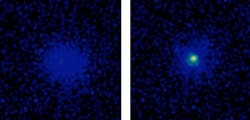La Palma, Canary Islands--A French-British team has demonstrated a major improvement to astronomical adaptive optics (AO), opening up the study of very faint sources over a very large field of view. It is used with the Canary demonstrator installed at the William Herschel 4.2 m telescope on La Palma, Canary Islands, Spain.
The test validates the feasibility of the Eagle instrument, which is dedicated to the characterization of 20 early-universe galaxies at a time, distributed within a 5-arcmin-diameter field of view (1/6 the apparent width of the full Moon). The Eagle will be part of the future 42 m European Extremely Large Telescope of the European Southern Observatory (ESO) to be installed in the Atacama desert, Chile.
The question of how the universe evolved from the Big Bang into its highly structured state of stars, galaxies, and clusters of galaxies is a key question for modern cosmology. If we could look back to the early epoch when the first stars started to emit light, we could observe the formation of the very first galaxies.
Correcting turbulence for 20 galaxies at a time
Before now, adaptive optics has only operated over fairly limited fields of view. To survey the early universe efficiently, however, larger areas of sky must be corrected all at once. This is the role of the Eagle instrument, designed in France and the United Kingdom. It will be able to look in detail at 20 target galaxies at a time, each one of which will be separately corrected for atmospheric distortion.
Because the first galaxies are too faint to allow us to measure the atmospheric distortions using their own light as a reference, a number of guide stars bright enough for this purpose must be found in the field of view; alternatively, artificial laser guide stars can be used.
Using a single deformable mirror to compensate for the entire field of view, as is done in conventional adaptive optics, is not feasible--and is not required. Because of the very small apparent size of the first galaxies, turbulence must only be compensated in a few small image zones distributed throughout the whole field of view.
A separate deformable mirror for each object
The new technology, called Multi-Object Adaptive Optics (MOAO), implements one deformable mirror per target in a dedicated optical train. Based on all the measurements performed on all the guide stars, all the deformable mirrors are controlled through a global-tomography approach to measuring the atmosphere. This new technique was demonstrated on-sky for the first time in September 2010 by the Eagle team at the William Herschel 4.2 m telescope. The new technology operated at the hoped-for performance level the first time it was used.
The next step will be to repeat this experiment but using laser-generated artificial guide stars generated in the atmosphere. This technique has been used elsewhere, but never to perform the tomographic measurements required by Canary. The use of laser guide stars is essential for Eagle today and for the E-ELT in the future.
A test star was imaged using MOAO with the correction system switched off and then with it on (see figure). The achieved performance is very similar to that obtained by conventional AO under the same conditions. Corrections were applied 150 times every second using information gathered from three other off-axis stars.

John Wallace | Senior Technical Editor (1998-2022)
John Wallace was with Laser Focus World for nearly 25 years, retiring in late June 2022. He obtained a bachelor's degree in mechanical engineering and physics at Rutgers University and a master's in optical engineering at the University of Rochester. Before becoming an editor, John worked as an engineer at RCA, Exxon, Eastman Kodak, and GCA Corporation.
